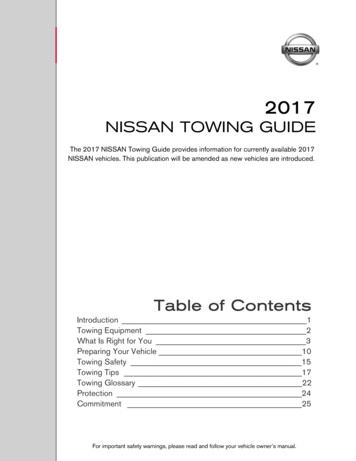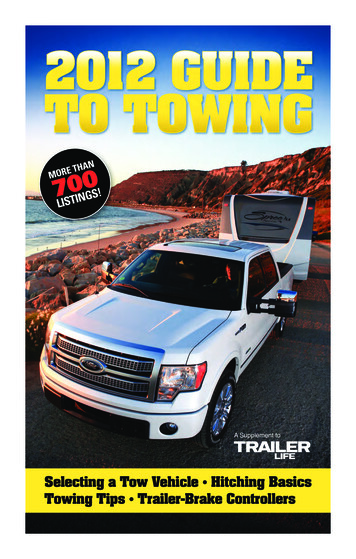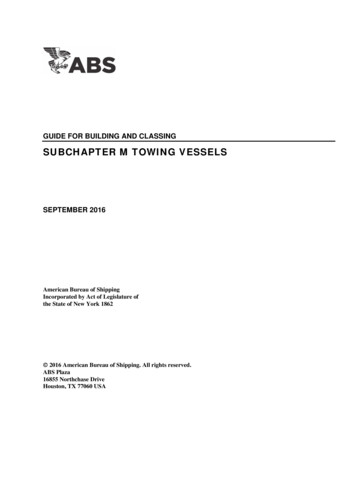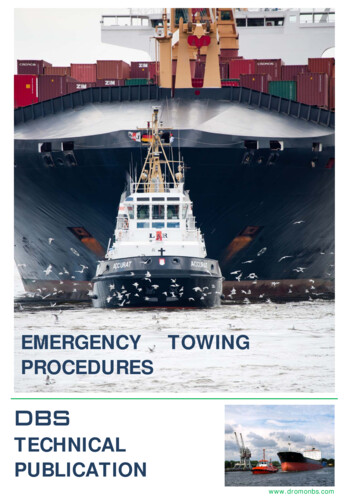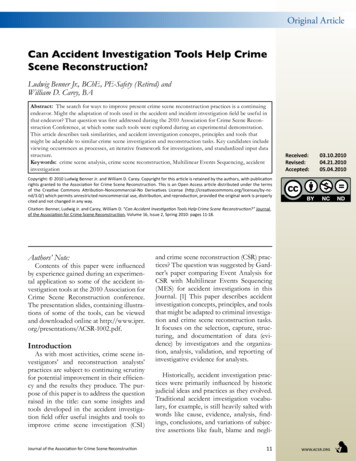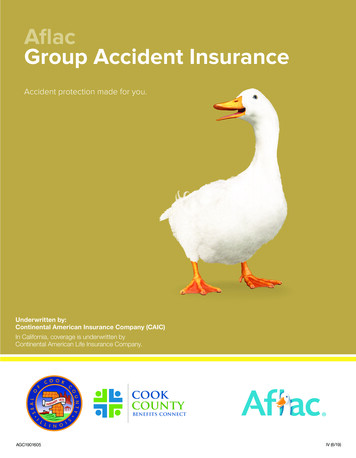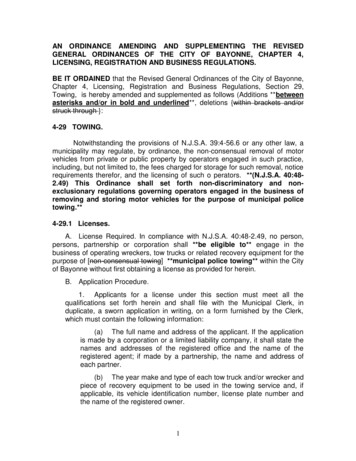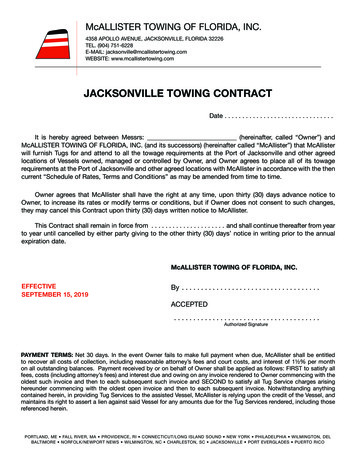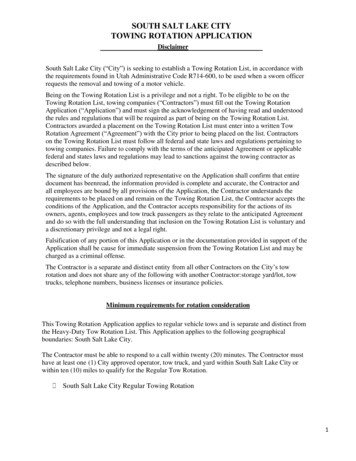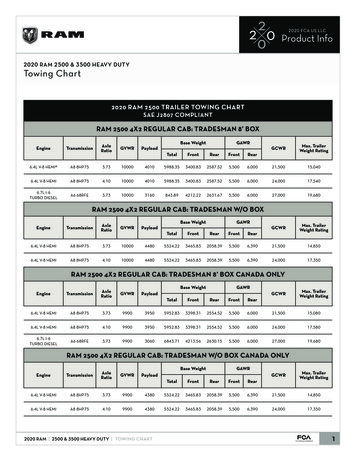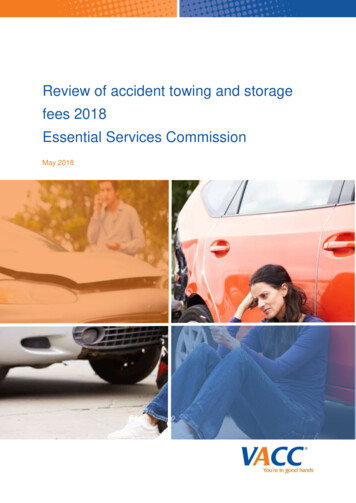
Transcription
Review of accident towing and storagefees 2018Essential Services CommissionMay 2018
ContentsAbout VACC . 3Executive Summary. 4VACC Responses to ESC proposed approach for review and assessment . 7Temporary storage for towing industry - actual costs . 10Location & Size of Tow Truck Depots . 10Industrial Premises – Demand and Supply Constraints . 10Motor vehicle storage space requirements . 11What costs should be included in storage? . 12Leasing costs per sq m . 12Administrative costs . 12Bad debts associated to outstanding storage fees . 16Storage Requirements. 16Storage Utilisation Rates . 17Storage Cost Analysis . 17Motorcycles . 19Conclusions . 192
ABOUT VACCThe Victorian Automobile Chamber of Commerce (VACC) is Victoria’s peak automotive industryassociation, representing the interests of more than 5,000 members in over 20 retail automotivesectors that employ over 50,000 Victorians.VACC members range from new and used vehicle dealers (passenger, truck, commercial,motorcycles, recreational and farm machinery), repairers (mechanical, electrical, body and repairspecialists, i.e. tow operators, radiators and engines), vehicle servicing (service stations, vehiclewashing, rental, windscreens), parts and component wholesale/retail and distribution and aftermarketmanufacture (i.e. specialist vehicle, parts or component modification and/or manufacture), andautomotive dismantlers and recyclers.In addition to VACC, its sister organisations – the Motor Trade Associations, represent theautomotive industry for their respective states.In respect to our towing operator division members, 95% of all Melbourne controlled area operatorsare VACC members.CONTACT DETAILSJohn GuestIndustry Policy and Division LeaderIndustrial Relations, Policy & EngagementVACCLevel 7 464 St Kilda Road Melbourne Vic 3004P: 03 9829 1142 M: 0418 329 527 F: 03 9820 3401 W: vacc.com.au3
EXECUTIVE SUMMARYIncreased costs since the last reviewSince 2013, the average leasing cost of premises where accident towing operators are located hasincreased from an average of 90 per sq m to about 120 per sq m for inner Melbourne and 100per sq m for outer Melbourne areas. As a result, storage fees are insufficient to recover the leasingcosts let alone the administrative costs and loss of storage fee revenue arising from uncollectedvehicles.Increased traffic congestion across the Melbourne Controlled area has been well documented overthe past several years and is likely to worsen with major infrastructure projects such as the Metrotunnel and the removal of 50 railway crossings. This has increased the average time of undertakingan accident tow. The VACC recommends that the ESC undertake a survey of accident towingoperators to ascertain the average time it takes to undertake an accident tow.BenchmarkingThe VACC strongly recommends that the ESC adopt the New South Wales Independent Pricing andRegulatory Tribunal (IPART) methodology used in its “Review of tow truck fees and licensing in NSW2014” for the setting of accident towing and storage fees.IPART used a whole of business approach rather than allocating a share of the total towing costs toaccident towing. This is in stark contrast to the ESC approach of estimating the towing costs that areattributable to accident towing vis-a-vis other forms of towing.IPART benchmarked other types of towing and modelled the hourly cost of towing activities withdifferent combinations of accident and trade tows, different business models and with different inputcosts. Importantly, IPART recognised the extent of utilisation of a tow truck affects the hourly costand the amount that an operator must charge to recover their costs.Further information needs to be collected to put benchmarked prices into perspective; namely thetowing segment, the type of business model (owner-operator without business premises, operatorwith business premises including the size of the premises); whether the operator undertakes multipletows with the same tow truck (e.g. dealerships, trade towing between body shops) size of tow truckfleet and average tow truck utilisation rates.4
Storage FeesIn respect to storage fees, IPART assessed the cost of land and also took into consideration theutilisation of storage spaces for accident damaged motor vehicles. As a result, the difference in thedaily rate for covered storage is currently 6 and 40 percent more in Sydney than in Melbourne.The ESC has not previously undertaken an assessment of land costs in respect to storage or theutilisation rate for storage space. The VACC would recommend that the leasing cost on a sq m basisshould be used rather than historical land sale values. The leasing cost together with outgoingsprovides a more accurate reflection of the current costs associated with providing storage. TheVACC provides detailed cost analysis that shows the storages rates need to be increasedsignificantly to recover leasing costs, administrative costs associated with storage, storage feelosses from uncollected vehicles and a reasonable rate of return.The VACC recommends that the ESC give consideration to adopting separate storage fees for innerand outer Melbourne suburbs as adopted in Sydney but retaining the covered and uncoveredcharges. On our calculations, the daily storage fees should be increased as follows: Inner Melbourne: covered storage 29.48, uncovered storage 17.81 Outer Melbourne covered storage 25.89, uncovered storage 14.21Motorcycle storage should be half of the aforementioned daily rates.Productivity Adjustment FactorThere are several fundamental limitations with the productivity adjustment factor as prescribed insection 212H of the Accident Towing Services Act 2007. Firstly, accident towing in the MelbourneControlled area is not a competitive market. The number of tow truck licences has been capped at421 licences for almost forty years and each accident towing operator is limited to the allocation zoneit has been given by VicRoads.Secondly, the productivity adjustment factor needs to include the productivity gains and losses thathave occurred across other key towing services that are provided by accident towing operators;specifically, the trade towing sector. Any increase or decrease in trade towing activities affects towtruck utilisation rates and the hourly cost to provide towing services.Thirdly, accident towing is subject to greater regulatory barriers compared with the transport sectorand this denies accident towing operators with the ability to improve processes and practices toreduce the hourly cost of accident towing. Specifically, the regulations prevent electronicauthorisation to two documentation and double-tows.5
The VACC also considers it is bit rich that Victorian Government regulatory fees are automaticallysubject to annual CPI increases without any requirement to deliver productivity improvements.In view of these regulatory restrictions, the VACC strongly recommends that the productivityadjustment factor for accident towing and storage fees be removed from the CPI (MelbourneTransport) annual adjustment mechanism.Basic SalvageThe ESC has dealt with this issue in its 2009 and 2013 reviews and recommended basic salvagecharges should be regulated each time yet the responsible Minister has not adopted itsrecommendations.Previous reviews have shown that the extent of excessive charging is minimal. In view of this, theVACC remains opposed to prescriptive price regulation unless the ESC can provide an evidencebased case that the transaction costs of challenging occasional disputes outweighs the benefits ofthe current regulatory regime.6
VACC RESPONSES TO ESC PROPOSED APPROACH FOR REVIEW AND ASSESSMENT1. Have there been any significant changes in the accident towing industry since our lastreview?As the ESC is aware, accident towing operators also undertake trade towing, and while aconsiderable amount of trade towing has been mostly contracted, insurance companies have begunto contract secondary tows (from the depot to the smash repairer). For example, RACV hascontracted a single towing company to undertake secondary tows from accident towing depots withinthe Melbourne Controlled area. As a result, the accident-towing market-share of trade towing hasfurther declined. RACV has contracted Nationwide Towing for its breakdown towing for many years.Most trade towing (break-down, trade, clearance and stolen vehicles) is contracted to mostly nonaccident towing operators. This has a significant impact on tow truck utilisation and the hourly costfor providing accident towing services.2. How have the costs of accident towing operators changed since our last review? Can anysignificant cost changes be supported with material illustrating these changes?The leasing cost of industrial buildings and land is usually valued on a per sq m basis and includesoutgoings (council rates and water rates). In 2014, our survey of industrial areas where accidenttowing operators are located revealed an average leasing cost of 90 per sq m across theMelbourne Controlled area. Our survey of industrial areas reveals an average leasing cost of 120per sq m for inner Melbourne and 100 per sq m for outer Melbourne areas. As a result, storage feesare insufficient to recover the leasing costs let alone the administrative costs and loss of storage feerevenue arising from uncollected vehicles. We provide detailed cost analysis of the temporarystorage of accident damaged vehicles in Question 5.Increased traffic congestion across the Melbourne Controlled area has been well documented overthe past several years and is likely to worsen with major infrastructure projects such as the Metrotunnel and the removal of 50 railway crossings. While accident towing operators have been able tomeet the 30 minute response time, some of our members are already experiencing difficulties inarriving at the road accident scene within this prescribed time. The average time to conduct anaccident tow that the ESC relied upon in past periodic reviews needs to be reviewed in light of thechanges to Melbourne’s traffic conditions. In view of this, the VACC recommends that the ESCshould survey accident towing operators to ascertain the average time it takes them to complete anaccident tow.7
3. What are your views on our proposal to continue our benchmarking approach to reviewaccident towing and storage fees?The VACC strongly recommends that the ESC adopt the New South Wales Independent Pricing andRegulatory Tribunal (IPART) methodology used in its “Review of tow truck fees and licensing in NSW2014” for the setting of accident towing and storage fees.IPART’s methodology combined a cost of service approach supported by benchmarking.IPART used a whole of business approach rather than allocating a share of the total towing costs toaccident towing. This is in stark contrast to the ESC approach of estimating the towing costsattributable to accident towing vis-a-vis other forms of towing.IPART benchmarked other types of towing and modelled the hourly cost of towing activities withdifferent combinations of accident and trade tows, different business models and with different inputcosts. Importantly, IPART recognised the extent of utilisation of a tow truck affects the hourly costand the amount that an operator must charge to recover their costs.IPART undertook benchmarking with a survey of accident and non-accident towing services. Similarto the ESC benchmarking, the survey revealed a wide range of towing prices. However, unlike theESC, IPART recognised that the extreme low and high ends reflected different business models andassociated costs in the towing industry.The previous benchmarking study simply collected prices from trade/breakdown towing operatorsand provided a wide range of prices. To understand the reasons for the wide range of prices, furtherinformation should have been collected to put the prices into perspective; namely the towingsegment, the type of business model (owner-operator without business premises, operator withbusiness premises including the size of the premises); whether the operator undertakes multipletows with the same tow truck (e.g. dealerships, trade towing between body shops) size of tow truckfleet and average tow truck utilisation rates.With this information, it is possible to understand the wide range of towing prices offered in themarket and to also calculate the average hourly rate for different segments and business models.8
4. Do you agree with the benchmarks we have previously used for the Melbourne accidenttowing industry? If not, what benchmarks would be more appropriate?The VACC has no issue with benchmarking accident and non-accident towing in other markets.However, there is little to be gained from benchmarking unless the differences in pricing are clearlyunderstood. To simply state the differences in fees between jurisdictions can be explained by thedifferences in cost structures, number of towing jobs per tow truck, opportunities for non-accidenttowing services, and regulatory and price setting arrangements is stating the obvious.The ESC could also benchmark long-term car parking fees (e.g. storage centres) for the purposes ofdetermining storage fees. However, if this is undertaken, the utilisation of car parking in thesecentres needs to be also collected to enable appropriate cost and revenue analysis.5. Are the current accident towing and storage fees appropriate? If not, do you consider theyshould increase or decrease?Storage fees have never reflected the actual costs associated with providing temporary storage ofaccident damaged motor vehicles. Property price increases over the past several years have furtherexacerbated the operating losses incurred by accident towing operators in providing temporarystorage.The storage fees need to take into account: leasing costs (including outgoings); administrative costs; storage fee losses from uncollected vehicles; and, a reasonable return.IPART undertook analysis of storage costs in different areas of Sydney using data on land valuesfrom NSW Land and Property on small industrial sites and also benchmarked outdoor long-termparking. In addition, IPART took into account the utilisation of storage yards. IPART recommended amaximum storage fee of 23 per day for inner-metro areas and 12 per day for outer-metro areas;and half of this rate for the storage of motorcycles. These storage fees clearly took into account thedifferent leasing costs across the Sydney metropolitan area.9
TEMPORARY STORAGE FOR TOWING INDUSTRY - ACTUAL COSTSIPART provided little background information and detail on its analysis and conclusions. In view ofthis, we provide the following information to assist the ESC to better understand the actual costsassociated with providing temporary storage.LOCATION & SIZE OF TOW TRUCK DEPOTSMost tow truck operators, with the exception of several operators in inner –Melbourne, are located inindustrial zone estates that provide suitable premises for their operations.In 2014, the VACC mapped and measured each accident tow truck depot to determine the size ofthe premises and the building/yard configurations. Land Victoria’s Land and Survey SpatialInformation mapping (LASSI) was used in conjunction with Google satellite maps to undertake landmeasurements. There have been minimal depot changes since 2014 so these results are stillrelevant.The key findings of this study revealed: the size of tow truck premises ranged from 450 to 9,900 sq m; an average depot size of 1,317 sq m; 19 or 49 percent of depots provided covered and uncovered car storage facilities; the uncovered areas in these premises accounted for 10% to 90% of the total area of thepremises, with most accounting for about 50% of the total area.INDUSTRIAL PREMISES – DEMAND AND SUPPLY CONSTRAINTSMarket conditions for industrial zones and regulation greatly restrict the ability of the accident towingoperator to obtain the optimal size building and yard to meet their business operation and storageneeds. As a result, many accident towing operators are more likely to have premises with somesurplus space, and for some operators in inner Melbourne, barely enough space to provide adequatestorage to support their average accident towing allocations.The development and redevelopment of industrial estates generally involves factories without a yard(mostly buildings with 60% office and 40% factory space) other than large industrial sites 20,000sq m that are too large for accident towing operator storage needs. There are very few premises inindustrial zones that have a building and yard, other than in well-established industrial estates. As aresult, there are limited choices and limited supply of premises with a building and a yard.10
As the ESC is aware, inner-Melbourne suburbs have fewer industrial zones, and local councils havebecome reluctant to approve an accident towing depot in other zones within their municipality.Accident towing operators must work within an allocation zone determined by VicRoads and mustobtain approval under the regulations from VicRoads to move a depot or transfer licences to depotlocated in another allocation zone. The probability of the latter occurring is extremely low for innerMelbourne allocation zones as VicRoads will not approve a transfer if the additional licences wouldresult in a reduction in the number of allocations to other licensees in the area.MOTOR VEHICLE STORAGE SPACE REQUIREMENTSMost motor vehicles require about 15 sq m of space (to ensure accessibility at the front, rear andboth sides of the vehicle for staff and also owners to safely retrieve personal belongings) and aminimum of 10 sq m of common road area to enable operators to maneuver a motor vehicle into andout of a designated parking bay. Accordingly, 25 sq m is required for each motor vehicle space.Due to the monthly fluctuation in accident tows, the towing operator needs to ensure that they haveappropriate storage capacity to meet peak periods of towing activity and to also factor in motorvehicles that stay at the depot longer than 7 days (such as uncollected motor vehicles). A sample ofauthorisation to tow documents were reviewed at a depot that revealed about 80 percent of accidenttows require storage at the depot, with the average vehicle in storage for 6 days and 15 percent ofvehicles remaining in storage for more than 7 days.In view of this, operators need to plan to have sufficient storage capacity not just for the expectednumber of tows that translate into storage but also for peak periods and for vehicles that remain instorage for greater than 7 days.For example, a tow operator that receives 500 allocations per annum would store 400 damagedvehicles per annum and require on a weekly basis, spaces for at least 10 motor vehicles (250 sq m),4 additional spaces for peak periods of towing (100 sq m) and 4 spaces (100 sq m) for uncollectedvehicles that tend to be in storage for more than 30 days. As a result, a minimum of 450 sq m wouldbe required in this example.11
WHAT COSTS SHOULD BE INCLUDED IN STORAGE?For the purposes of allocating expenses, the leasing costs of the office, repair and maintenanceworkshop, loading bays for tow trucks and on-site parking lots for drivers, administrative staff andvisitors as well as the common driveways at the front of the premises should be allocated to the basefee for undertaking an accident tow or any other towing activity such as secondary, trade andbreakdown towing.There are four cost components to providing temporary storage: The leasing costs for the covered area within the building that is set aside for car storageand all of the other outside area that is potentially used for temporary car storage isappropriate for cost allocation to the storage of damaged motor vehicles. Administrative support that is directly related to providing services associated with thestorage of damaged motor vehicles. Bad debts related solely to outstanding storage fees. A reasonable rate of return. IPART used an operating profit margin of 10% based on ABSindustry data.LEASING COSTS PER SQ MA survey of industrial zones across the areas where accident towing depots are located wasconducted in 2014 and found an average lease cost of 90 per sq m (including outgoings). A recentsurvey has found the average lease cost (including outgoings) has increased to 120 per sq m forinner Melbourne and 100 per sq m for outer Melbourne. For yards, the cost per sq m is estimated at 55 per sq m for inner Melbourne and 35 per sq m for outer Melbourne.ADMINISTRATIVE COSTSAccident towing operators provide a service to owners and insurers with the storage of accidentdamaged motor vehicles. Unlike the car parking industry that relies on automated ticketing, accidentmotor vehicle storage at a depot requires by regulation to be staffed.The VACC has estimated about 30 minutes is required per stored vehicle to assist owners retrievepersonal belongings, organise arrangements for a secondary tow with the owner/insurer, clean-uphazardous materials and prepare in accordance with regulation periodic written statements for theowner/insurer of outstanding storage fees and the preparation of paperwork for the disposal ofuncollected vehicles. These tasks are discussed in detail on the following pages.12
The average administrative cost is 35 per vehicle stored. 1In this case, 70,000 salary 1672 hours 41.86 x 1.120 (salary on-costs) 46.88 x 1.5(overheads) 70.32 hourly rate.Many owners come to the depot after the accident to retrieve personal belongings. Depot staffprovide assistance to owners to ensure that they do not injure themselves where the vehicle hasbeen badly damaged (broken glass and sharp protrusions), and to also ensure that owners do notsteal valuables from other damaged motor vehicles that still have personal belongings waiting to becollected. This usually takes on average about 15 minutes per vehicle.Depot staff are also in contact by phone/email with the owner or the insurer to discuss arrangementsfor the vehicle to be towed to a smash repairer or an auction house where the damaged motorvehicle is written-off.Depending on the size of storage capacity, other vehicles need to be moved when a vehicle that hasbeen in storage for more than 7 days has become blocked by recently towed vehicles and cannot beretrieved without first moving other vehicles. Some operators use forklifts to maneuver vehicles.Some motor vehicles continue to leak chemicals and fuel after they have been put into storage andappropriate clean-up of these hazardous substances is required from an occupational health andsafety perspective as well as a public liability perspective for owners that come to the depot to collectpersonal belongings.A significant administrative cost is related to the regulation of storage. Section 151 of the AccidentTowing Services Act 2007 requires the licence holder to provide the owner within 10 business daysafter the vehicle has been towed to the depot, written notice of the amount of storage charges owing,the daily storage rate and that the charges are continuing to accumulate. A subsequent written noticemust be sent to the owner with the same information before the expiry of each period of 20 businessdays.IPART did not include this as an administrative cost as it would appear that the NSW Tow Truck Actand Regulations do not require periodic written statements to the owner/insurer of the outstandingstorage charges.Most accident towing businesses prepare written notices after 3 days, 7 days and a final reminderafter 30 days to expedite the process for the disposal of uncollected damaged vehicles and torecover some of the outstanding debt owed by the owner. Part 4.2 The Australian Consumer Law &Fair Trading Act 2012 specifically requires for vehicles valued less than 1,000, the licence holdermust provide written notice to the owner of its intention to dispose of the vehicle. After giving writtenThis is based on the Department of Treasury & Finance’s Victorian Guide to Regulation fordetermining the hourly cost of labour.113
notice, the accident towing operator must retain the vehicle for a further 28 days. If the accidenttowing operator cannot contact the owner despite making attempts to notify them in writing, theoperator has to wait 60 days before disposing of the vehicle.For vehicles worth more than 1,000, the accident towing operator must obtain a written searchresult from the Personal Properties Securities Register (PPSR) website by quoting the vehicle’schassis number and vehicle identification number (VIN). Depending on the outcome of the PPSRsearch result, the accident towing operator must give written notice of the intention to dispose of thevehicle to: the person who left the vehicle; anyone who has registered an interest in the vehicle on the PPSR; anyone else the accident towing operator is aware of who has (or claims to have) aproprietary or security interest in the vehicle; and, the owner or registered operator of the vehicle.The accident towing operator can apply to VicRoads for a registered operator’s details for a fee. Theapplication must in the form of a statutory declaration, and must include: the accident towing operator’s business name, address and ABN; the vehicle’s last registration number (if available) and VIN; if the accident towing operator has given written notice of the intention to dispose of thevehicle to anyone, a copy of that notice; if the accident towing operator has applied to a court or VCAT, a copy of the application;and, If the accident towing operator has obtained a PPSR search result, a copy of that search.After giving written notice of the intention to dispose, the accident towing operator must retain thevehicle for 28 days, after which the vehicle can be disposed if the person who left the vehicle has notcollected the vehicle within the 28 days. If the accident towing operator cannot contact the ownerdespite making attempts to notify them in writing, the operator has to wait 180 days before disposingof the vehicle.An accident towing operator cannot keep high-value uncollected vehicles for its own use. It can onlydispose of them by public auction or private sale.If the accident towing operator sells the vehicle at public auction, the auction must be advertised atleast 7 days in advance or held over a period of least seven days (on-line auction). A public auctionwould be rarely used as a means of sale other than for a prestige vehicle.14
If the accident towing operator sells the vehicle by private sale, it must: Give written notice to all of the people required; Reasonably believe that the best price could only be achieved by private sale; and, Take reasonable care to ensure that the vehicle is sold for the best price that can reasonablybe obtained under the circumstances at the time of sale.As can be seen, there is a reasonable amount of paperwork notifying owners of the outstandingstorage charges and a considerable amount of paperwork that needs to be completed foruncollected vehicles that ultimately need to be disposed. This is part of the administrative support fordamaged vehicle storage and this cost should be included in storage fees.It is inappropriate from a policy perspective, for the estimated 20 percent of accident damagedvehicles that are towed to another destination (home or smash repairer) to have to incur theregulatory paperwork costs associated with Section 151 of the Accident Towing Services Act 2007and Part 4.2 The Australian Consumer Law & Fair Trading Act 2012.There are several reasons for the risk management efforts exercised by accident towing operators inthis process. Many accident towing operators do not have ample storage capacity and they needdamaged vehicles in storage to be towed out of the yard to create space for incoming damagedvehicles on a weekly basis.Secondly, accident towing operators seek to recover some of their costs through the disposalprocess for bad debts. Badly damaged vehicles are invariably sent to the wreckers and sold forabout 200. This does not recoup the outstanding debt that might be about 300 for the tow and 450 for one month of storage. This represents a loss of 550 per vehicle. Where the wrecker ismore than 30 minutes from
For example, RACV has contracted a single towing company to undertake secondary tows from accident towing depots within the Melbourne Controlled area. As a result, the accident-towing market-share of trade towing has further declined. RACV has contracted Nationwide Towing for its breakdown towing for many years.
